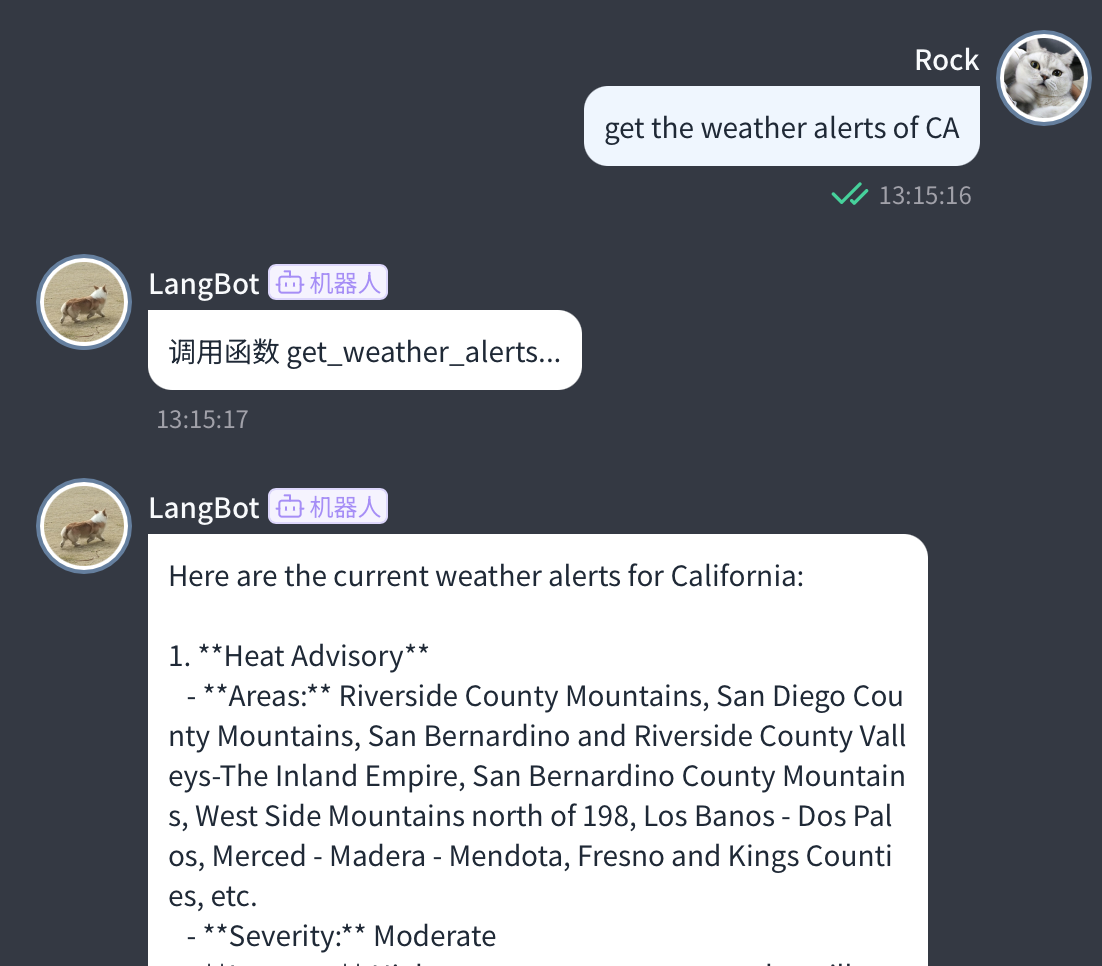组件:工具
LangBot 内置的 Local Agent 在执行期间会根据场景调用工具以与外界交互,目前支持通过插件和 MCP 两种方式添加工具。
添加工具组件
单个插件中能添加任意数量的工具,请在插件目录执行命令lbp comp Tool,并根据提示输入工具的配置。
bash
➜ HelloPlugin > lbp comp Tool
Generating component Tool...
Tool name: get_weather_alerts
Tool description: Get weather alerts for a US state.
Component Tool generated successfully.
组件 Tool 生成成功。现在即会在components/tools/目录下生成get_weather_alerts.yaml和get_weather_alerts.py文件,.yaml定义了工具的基础信息,.py是该工具的处理程序:
bash
➜ HelloPlugin > tree
...
├── components
│ ├── __init__.py
│ └── tools
│ ├── __init__.py
│ ├── get_weather_alerts.py
│ └── get_weather_alerts.yaml
...清单文件:工具
yaml
apiVersion: v1 # 请勿修改
kind: Tool # 请勿修改
metadata:
name: get_weather_alerts # 工具名称,供 LLM 识别
label:
en_US: GetWeatherAlerts # 工具显示名称,用于显示在 LangBot 的 UI 上,支持多语言
zh_Hans: GetWeatherAlerts
description:
en_US: 'Get weather alerts for a US state.' # 工具描述,用于显示在 LangBot 的 UI 上,支持多语言。可选
zh_Hans: '获取美国某个州的天气预警'
spec:
parameters: [] # 工具参数,由 LLM 根据对话上下文生成值
llm_prompt: 'Get weather alerts for a US state.' # 工具提示词,供 LLM 判断是否调用该工具
execution:
python:
path: get_weather_alerts.py # 工具处理程序,请勿修改
attr: GetWeatherAlerts # 工具处理程序的类名,与 get_weather_alerts.py 中的类名一致插件处理
默认会生成如下代码(components/tools/<工具名称>.py),您需要在GetWeatherAlerts类的call方法中实现此工具的调用和返回逻辑。
python
# Auto generated by LangBot Plugin SDK.
# Please refer to https://docs.langbot.app/en/plugin/dev/tutor.html for more details.
from __future__ import annotations
from typing import Any
from langbot_plugin.api.definition.components.tool.tool import Tool
from langbot_plugin.api.entities.builtin.provider import session as provider_session
class GetWeatherAlerts(Tool):
async def call(self, params: dict[str, Any], session: provider_session.Session, query_id: int) -> str:
"""Fill your tool code here"""
return {}在 call 方法中,实现该工具:
INFO
天气获取工具用例来自 MCP 的 Server 编写示例。
python
from __future__ import annotations
from typing import Any
from langbot_plugin.api.definition.components.tool.tool import Tool
from langbot_plugin.api.entities.builtin.provider import session as provider_session
import httpx
# Constants
NWS_API_BASE = "https://api.weather.gov"
USER_AGENT = "weather-app/1.0"
async def make_nws_request(url: str) -> dict[str, Any] | None:
"""Make a request to the NWS API with proper error handling."""
headers = {
"User-Agent": USER_AGENT,
"Accept": "application/geo+json"
}
async with httpx.AsyncClient() as client:
try:
response = await client.get(url, headers=headers, timeout=30.0)
response.raise_for_status()
return response.json()
except Exception:
return None
def format_alert(feature: dict) -> str:
"""Format an alert feature into a readable string."""
props = feature["properties"]
return f"""
Event: {props.get('event', 'Unknown')}
Area: {props.get('areaDesc', 'Unknown')}
Severity: {props.get('severity', 'Unknown')}
Description: {props.get('description', 'No description available')}
Instructions: {props.get('instruction', 'No specific instructions provided')}
"""
class GetWeatherAlerts(Tool):
async def call(self, params: dict[str, Any], session: provider_session.Session, query_id: int) -> str:
"""Fill your tool code here"""
state = params.get("state", "CA")
url = f"{NWS_API_BASE}/alerts/active/area/{state}"
data = await make_nws_request(url)
if not data or "features" not in data:
return "Unable to fetch alerts or no alerts found."
if not data["features"]:
return "No active alerts for this state."
alerts = [format_alert(feature) for feature in data["features"]]
return "\n---\n".join(alerts)在这个工具中,我们要从params中获取state参数,并调用 NWS API 获取该州的天气预警,故我们需要在清单文件的parameters中定义state参数。
parameters 的格式遵循 JSON Schema,受 OpenAI Function Calling 特性支持,且其根类型固定为type: object,请在properties中添加参数,并在required中添加必填参数说明。
yaml
...
spec:
parameters:
type: object # 请勿修改
properties: # 请勿修改,在此处添加参数
state:
type: string
description: 'Two-letter US state code (e.g. CA, NY)'
required: # 在此添加必填参数说明
- state
...本工具中还使用了httpx库,我们需要在插件目录的requirements.txt中添加httpx依赖。
txt
# HelloPlugin/requirements.txt
langbot-plugin # 默认已存在
httpx现在在插件目录执行命令lbp run,启动调试。在 LangBot 中配置支持工具调用的模型,并在对应流水线上选择使用该模型,即可使用该工具。

接下来做什么
您已经了解了工具的基本用法,接下来可以:
- 查看插件通用 API
